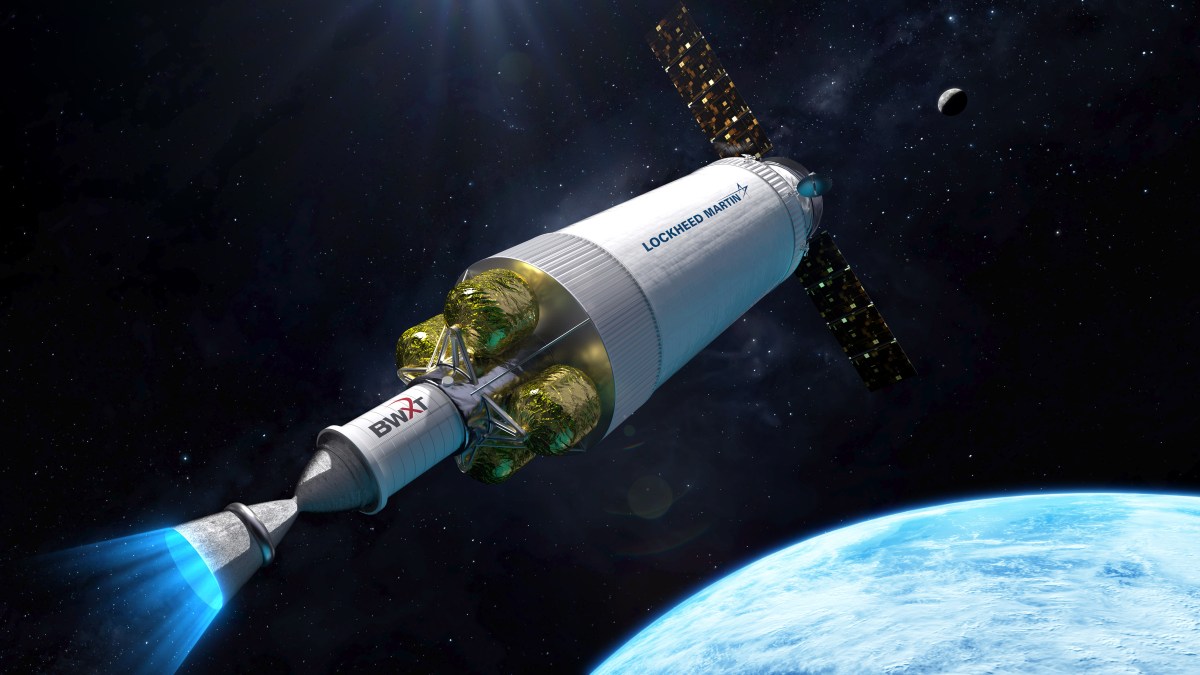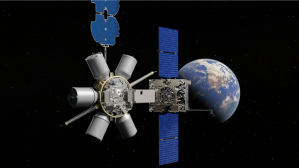Lockheed Martin pitching nuclear propulsion portfolio for defense space mobility, logistics

COLORADO SPRINGS, Colo. — The U.S. government has begun funding the development of different nuclear-powered spacecraft for civil and commercial use cases, and Lockheed Martin believes that the technology could play a key role in military space operations once it has matured.
The company is on contract for three key nuclear-powered spacecraft programs with various government agencies as the U.S. looks to return to the moon and eventually begin exploration of Mars. Each effort tackles a different type of space-based nuclear power for different mission areas — from efficient and quick transport through space to sustainable and continuous power on the Moon.
And while the government is focused on how space nuclear propulsion can support civil and commercial applications, there is also some appetite to use the technology in the defense sector — particularly for space servicing, mobility and logistics (SAML) missions, according to Jeff Schrader, vice president of global situation awareness at Lockheed Martin.
“When you launch a satellite, it stays in that orbit … You’ve got fixed fuel tanks, you’ve got a fixed amount of battery life which limits life extensibility, as well as its ability to move in and around, perhaps, other threats that they may be seeing,” Schrader told DefenseScoop on Friday during an interview at the annual Space Symposium in Colorado Springs.
U.S. Space Command has sent out a demand signal to the Space Force and others to get after capabilities that will enable what it refers to as “dynamic space operations” — or the ability to freely move through space without worrying about wasting fuel or power. In response, the service has set up a SAML program office and wants to allocate $20 million in research-and-development funds to the technology in fiscal 2025.
While much of the focus has been on refueling satellites in orbit, Schrader emphasized that spacecraft either powered via nuclear thermal propulsion or nuclear electric propulsion could be another way that satellites are able to freely move on orbit.
“This thing could actually potentially pick up and move a satellite to a different orbit that the original satellite was never meant to be in and allow it to do multi-orbit missions,” he said, adding that doing so could be done very quickly.
Kate Watts, Lockheed Martin Space’s vice president of mission strategy and advanced capabilities for exploration, explained that space nuclear propulsion systems offer significant improvements in energy density when compared to conventional chemical propulsion — opening the door for a new era of space architectures and missions that aren’t limited by size, weight and power.
“A gummy bear-sized amount of uranium … is about the same energy density as 500 barrels of oil or 1.8 [NASA Space Launch System] upper stages,” Watts said on April 8 during a meeting with reporters ahead of the symposium. “It’s a ton of energy packed in a very small space, which is now allowing you to no longer be power-limited like we are today, and fuel-limited once we develop these systems.”
Lockheed Martin is currently developing both types of propulsion systems for the government. In 2023, the company was tapped by the Defense Advanced Research Projects Agency and NASA to develop the spacecraft for the Demonstration Rocket for Agile Cislunar Operations (DRACO) program, which looks to advanced nuclear thermal propulsion technologies. An on-orbit demonstration of DRACO’s nuclear reactor is scheduled for 2027.
At the same time, Lockheed is one of three companies contracted by the Air Force Research Lab for the Joint Emergent Technology Supplying On-orbit Nuclear Power (JETSON) program — an effort that focuses on advancing nuclear electric propulsion.
Intuitive Machines and Westinghouse Government were also picked by AFRL for the program’s preliminary design review stage, and all three companies will have the option to advance to critical design review by 2025.
The company is involved in the early stages of a nuclear electric power system for NASA under its Fission Surface Power program that will develop technology to continuously power future infrastructure on the moon and Mars.
The technology has other uses beyond moving satellites between orbits, such as on-orbit servicing, Schrader said. Satellites could dock onto a nuclear-powered space vehicle to recharge its batteries to extend its lifespan, representing “a huge cost-savings for the government if we can get more life out of cheaper satellites,” he explained.
That could also extend to satellites in commercial constellations, enabling the Space Force and U.S. government to better leverage both commercial and Defense Department resources for military applications, Schrader added.
“We’ve developed this for a DOD case, but say we put a port — like our [Augmentation System Port Interface] port and our software solution — to go do docking on this, we can sell that perhaps or include it in some of the commercial installations as this gets more and more involved,” he said.
Overall, the company says its portfolio of nuclear-powered space capabilities could reach initial operational capability by 2030, Watts said.
To get space nuclear propulsion across the finish line, Schrader said Lockheed Martin is actively working with DARPA’s Tactical Technology Office to move the technology to a transition partner to understand how nuclear-powered spacecraft can fit into military operations.
He added that there “hasn’t been a ton of discussion” yet with Space Operations Command (SpOC) or Space Training and Readiness Command (STARCOM) on things like concepts of operations and training requirements, but having those conversations is a huge goal as DRACO and other space nuclear propulsion programs continue to develop.
“If this is something that’s going to change the paradigm, we’ve got to start working with SpOC and with STARCOM and the acquisition community to say: ‘Hey, if this were to be there, let’s start talking about how that could change your training paradigms’ and all those kinds of things,” Schrader said.






